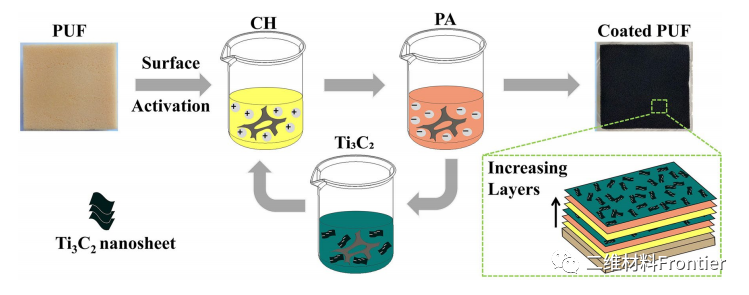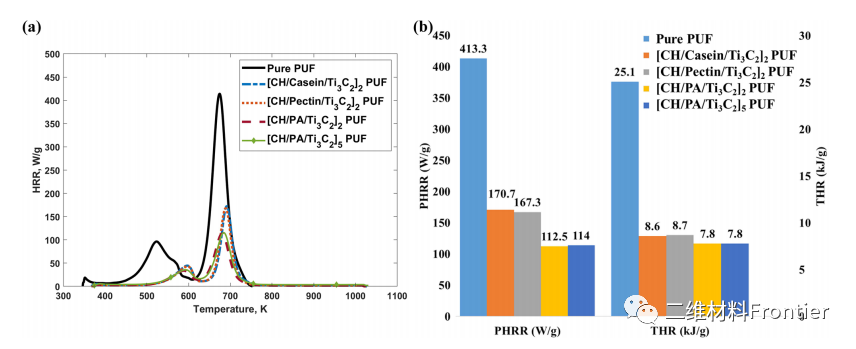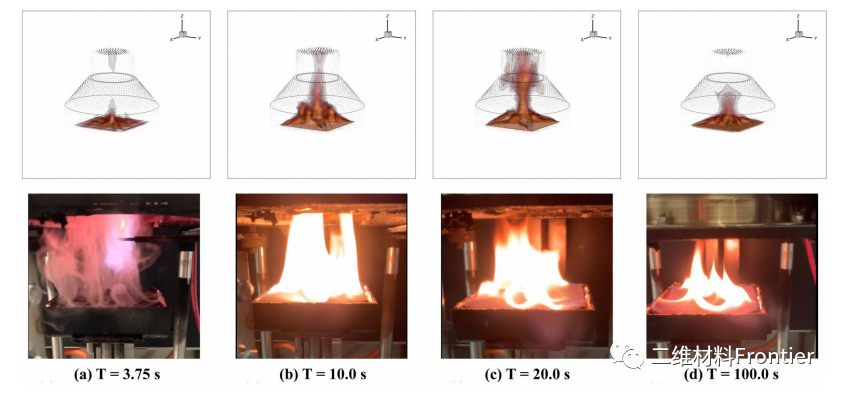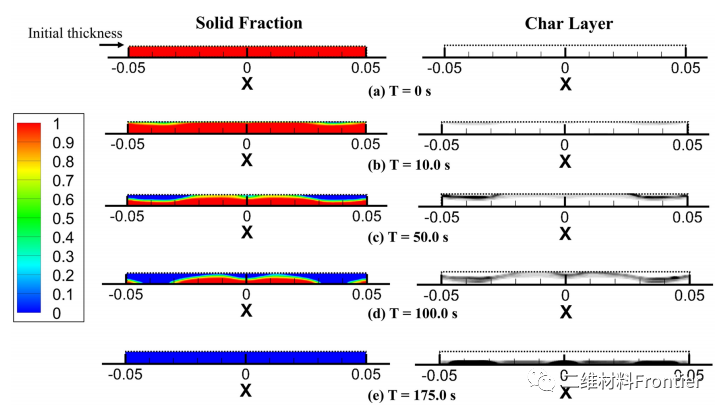Study on Fire performance of MXene Composites as Flame retardant
QQ Academic Group: 1092348845
Detailed
I. Overview of the article.
In recent years, the discovery of two-dimensional transition metal materials has become an excellent candidate for the preparation of nanostructured flame retardants. This paper reports an environment-friendly flexible polyurethane foam (PUF) flame retardant synthesized from MXene (Ti3C2) and biomass materials including phytic acid (PA), casein, pectin and chitosan (CH). The results showed that covering PUF with three layers of CH/PA/Ti3C2 layer by layer reduced the peak heat release and total smoke release by 51.1% and 84.8%, respectively. These remarkable improvements exceed the improvements in the CH/Ti3C2 coating. In order to further understand the basic phenomena of smoke and smoke reduction, a pyrolysis model with surface regression was developed to simulate smoke propagation and carbon layer.Genetic algorithm is used to determine the optimal parameters to describe the thermal degradation rate. The excellent flame retardancy of CH/PA/Ti3C2 results from the shielding and carbonization effect of MXene and biomass materials containing aromatic rings, phenols and phosphorus compounds.
Second, guided reading of picture and text.

Fig. 1. Schematic diagram of PUF process for preparing CH/PA/Ti3C2 coating by LbL method.

Figure 2. SEM image (a, b) neat PUF; (c, d) [CH/PA] 1 coating PUF; (e, f) [CH/PA/Ti3C2] coating PUF; (g) CH/PA/Ti3C2] 1 EDS mapping image of coating PUF.

Figure 3. (a) HRR curve and MCC results of (b) pure and all coated PUF.

Table 1 results of UL-94 horizontal combustion test.

Figure 4. Experimental images of 35kW/m2 cone calorimeter simulation and CH/PA/Ti3C2] 3PUF.

Figure 5. The two-dimensional contour map of solid fraction regression and carbon layer formation of [CH/PA/Ti3C2] 3 PUF during combustion time: (a) T = 0 s, (b) T = 10.0 s, (c) T = 50.0 s, (d) T = 100 s, and (e) T = 175.0 s.
III. Summary of the full text.
The authors developed and demonstrated a new nanostructure FR coating, which can significantly inhibit the flammability of polyurethane foam. Two-dimensional transition metal MXene (Ti3C2) was hybridized with casein, pectin and PA by LbL method.Various tests, including cone calorimetry, thermogravimetry, micro-combustion and UL-94 horizontal combustion test, show that [CH/PA/Ti3C2] 3 coating can reduce pHRR, THR, PSPR, TSR, COPR, and CO2PR by 51.1%, 40.1%, 66.7%, 84.8%, 60.4% and 69.1%, respectively. In addition, the paper proposes a high-density computational fluid dynamics to accurately capture potential FR mechanisms and predict outstanding scores and smoke reductions. Using the systematic numerical modeling framework, including the extraction of pyrolysis reaction rate by genetic algorithm and the application of LES-based fire model, the CFD-based analysis model with internal surface regression pyrolysis module explains the basic thermal decomposition rate and the kinetics of FR coating PUF. The calculated results are in good agreement with the experimental results in terms of HRR, TTI and combustion time. By combining the solid interface tracking and carbon formation model, the model can replicate the fire intensity reduction caused by the addition of CH/PA/Ti3C2 coating. The nanostructured CH/PA/Ti3C2 coating applied on PUF shows a significant potential to replace halogenated flame retardants, and has the advantages of reducing toxicity and improving biodegradability.
This information is from the Internet for academic exchange only. if there is any infringement, please contact us to delete it immediately.
In recent years, the discovery of two-dimensional transition metal materials has become an excellent candidate for the preparation of nanostructured flame retardants. This paper reports an environment-friendly flexible polyurethane foam (PUF) flame retardant synthesized from MXene (Ti3C2) and biomass materials including phytic acid (PA), casein, pectin and chitosan (CH). The results showed that covering PUF with three layers of CH/PA/Ti3C2 layer by layer reduced the peak heat release and total smoke release by 51.1% and 84.8%, respectively. These remarkable improvements exceed the improvements in the CH/Ti3C2 coating. In order to further understand the basic phenomena of smoke and smoke reduction, a pyrolysis model with surface regression was developed to simulate smoke propagation and carbon layer.Genetic algorithm is used to determine the optimal parameters to describe the thermal degradation rate. The excellent flame retardancy of CH/PA/Ti3C2 results from the shielding and carbonization effect of MXene and biomass materials containing aromatic rings, phenols and phosphorus compounds.
Second, guided reading of picture and text.

Fig. 1. Schematic diagram of PUF process for preparing CH/PA/Ti3C2 coating by LbL method.

Figure 2. SEM image (a, b) neat PUF; (c, d) [CH/PA] 1 coating PUF; (e, f) [CH/PA/Ti3C2] coating PUF; (g) CH/PA/Ti3C2] 1 EDS mapping image of coating PUF.

Figure 3. (a) HRR curve and MCC results of (b) pure and all coated PUF.

Table 1 results of UL-94 horizontal combustion test.

Figure 4. Experimental images of 35kW/m2 cone calorimeter simulation and CH/PA/Ti3C2] 3PUF.

Figure 5. The two-dimensional contour map of solid fraction regression and carbon layer formation of [CH/PA/Ti3C2] 3 PUF during combustion time: (a) T = 0 s, (b) T = 10.0 s, (c) T = 50.0 s, (d) T = 100 s, and (e) T = 175.0 s.
III. Summary of the full text.
The authors developed and demonstrated a new nanostructure FR coating, which can significantly inhibit the flammability of polyurethane foam. Two-dimensional transition metal MXene (Ti3C2) was hybridized with casein, pectin and PA by LbL method.Various tests, including cone calorimetry, thermogravimetry, micro-combustion and UL-94 horizontal combustion test, show that [CH/PA/Ti3C2] 3 coating can reduce pHRR, THR, PSPR, TSR, COPR, and CO2PR by 51.1%, 40.1%, 66.7%, 84.8%, 60.4% and 69.1%, respectively. In addition, the paper proposes a high-density computational fluid dynamics to accurately capture potential FR mechanisms and predict outstanding scores and smoke reductions. Using the systematic numerical modeling framework, including the extraction of pyrolysis reaction rate by genetic algorithm and the application of LES-based fire model, the CFD-based analysis model with internal surface regression pyrolysis module explains the basic thermal decomposition rate and the kinetics of FR coating PUF. The calculated results are in good agreement with the experimental results in terms of HRR, TTI and combustion time. By combining the solid interface tracking and carbon formation model, the model can replicate the fire intensity reduction caused by the addition of CH/PA/Ti3C2 coating. The nanostructured CH/PA/Ti3C2 coating applied on PUF shows a significant potential to replace halogenated flame retardants, and has the advantages of reducing toxicity and improving biodegradability.
This information is from the Internet for academic exchange only. if there is any infringement, please contact us to delete it immediately.
- Previous£º Intragranular defects
- Next£º A Rising 2D Star: Nove


 Academic Frontier
Academic Frontier